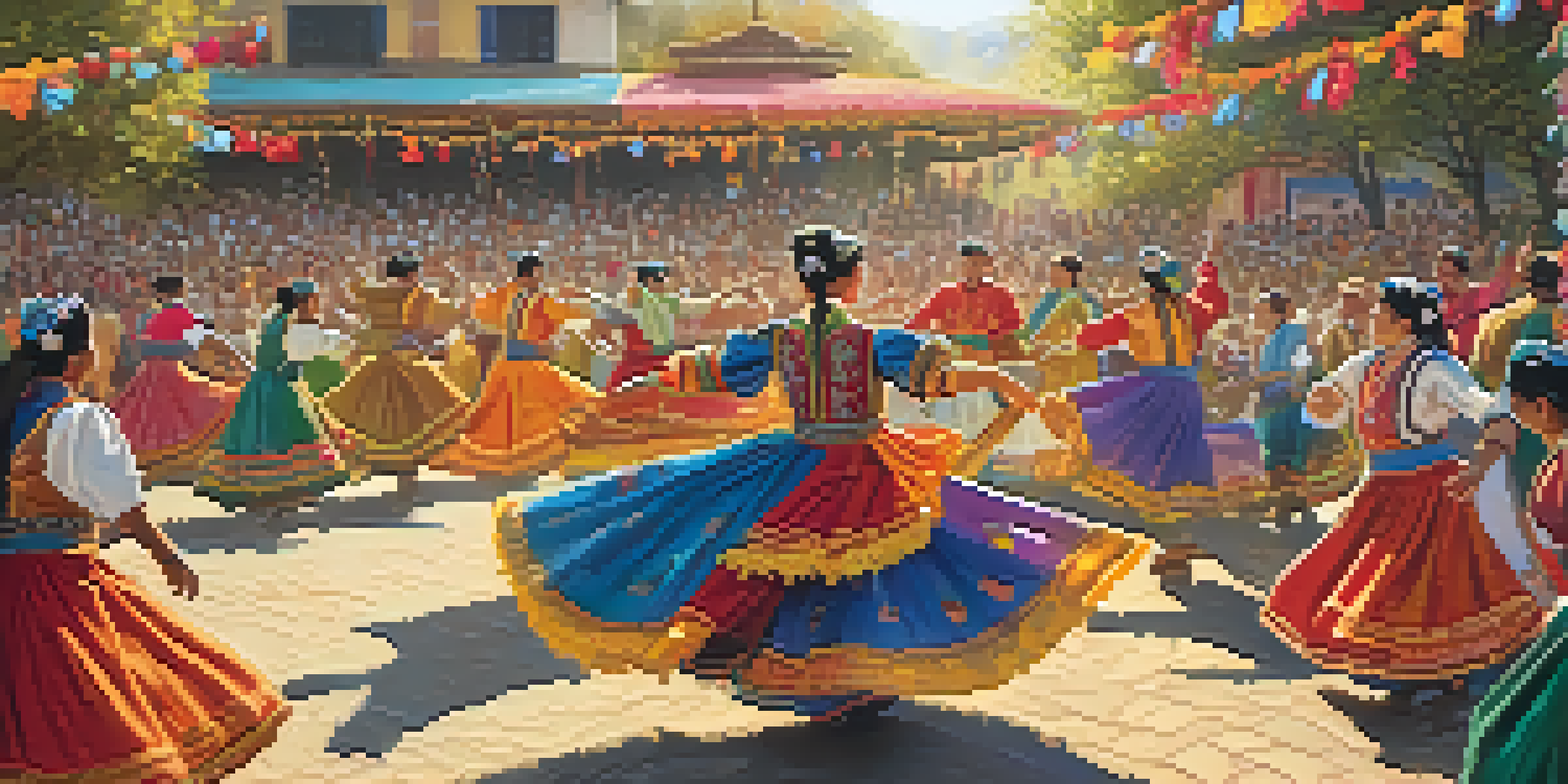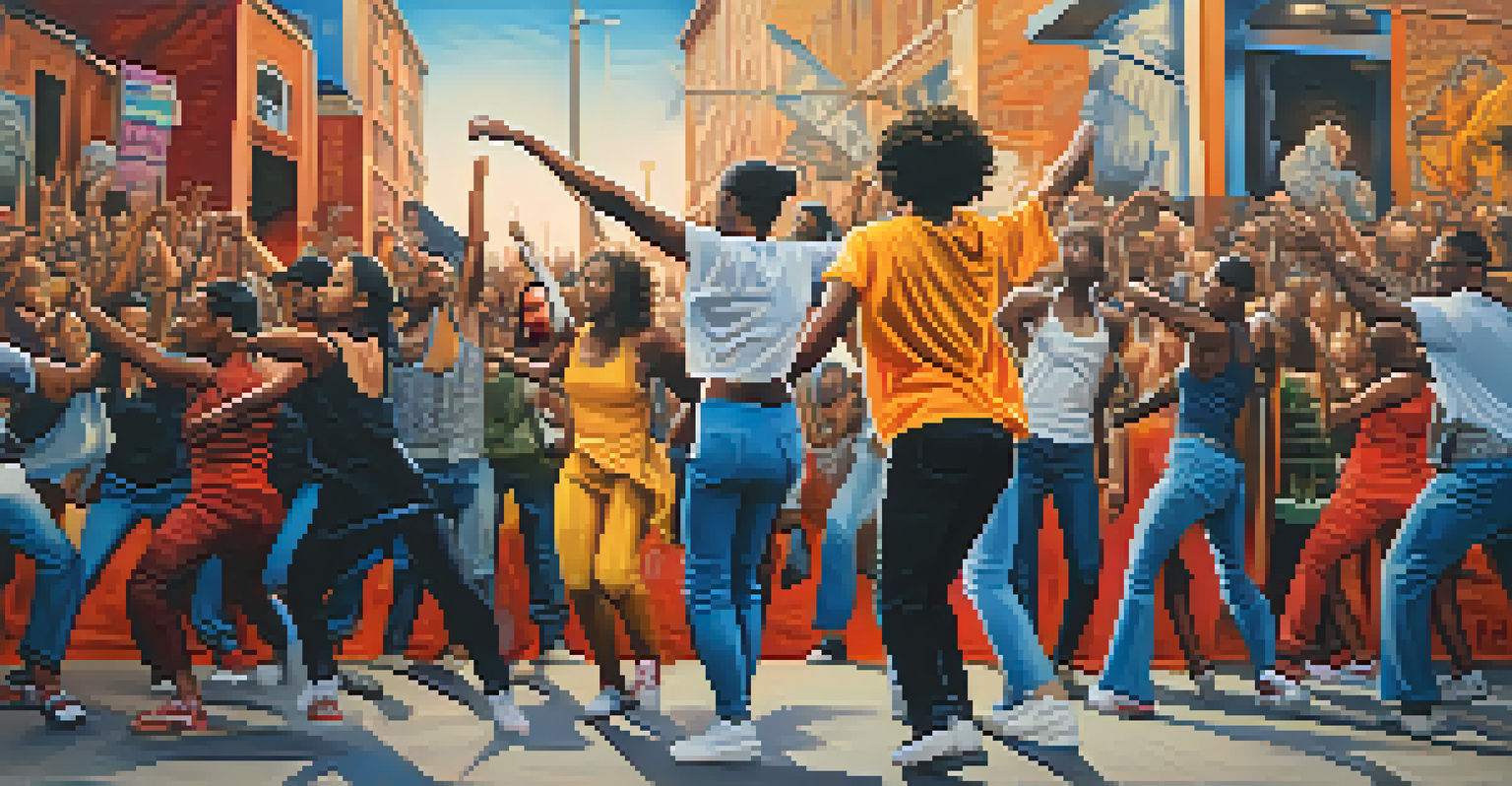The Impact of Dance on Cultural Identity and Expression

Dance as a Reflection of Cultural Heritage
Dance serves as a vibrant mirror of cultural heritage, encapsulating traditions, stories, and values. For instance, traditional folk dances often depict historical events, local legends, or agricultural practices that define a community. This connection to the past allows individuals to feel a sense of belonging and pride in their cultural roots. Moreover, it fosters intergenerational bonds as older generations pass down their dance practices to the younger ones, ensuring that cultural narratives continue to thrive.
Dance is the hidden language of the soul.
Through its movements and rhythms, dance conveys messages that words sometimes cannot express. Each gesture can encapsulate a range of emotions, from joy to sorrow, ultimately creating a shared experience among dancers and audiences alike. In this way, dance becomes a universal language that transcends barriers, promoting understanding and appreciation of diverse cultures. As people engage with these traditional forms, they not only preserve their heritage but also empower themselves and their communities.
In an increasingly globalized world, dance remains a vital way for individuals to explore and assert their cultural identity. Whether through community performances, festivals, or social gatherings, these expressions of dance foster a sense of unity and pride. The vibrant costumes and unique styles often serve as a visual representation of a culture's richness, encouraging dialogue and connection between different communities.
Dance as a Form of Personal Expression
Beyond cultural heritage, dance allows individuals to express their personal identities and emotions. This can be seen in various dance styles, such as contemporary or hip-hop, where dancers often infuse their unique experiences and perspectives into their movements. By doing so, they create a personal narrative that resonates with both themselves and their audience, allowing for a deeper connection. This form of expression can be liberating, enabling individuals to communicate feelings that might be difficult to articulate verbally.

For many, dance also serves as an outlet for self-discovery and exploration. As individuals engage with different styles and techniques, they often find new ways to express their thoughts, beliefs, and even struggles. This journey of self-exploration can be therapeutic, offering a safe space for reflection and growth. Through dance, people can reclaim their narratives, empowering them to overcome personal challenges and celebrate their uniqueness.
Dance Reflects Cultural Heritage
Dance serves as a vibrant expression of cultural heritage, preserving traditions and fostering a sense of belonging.
Additionally, dance encourages collaboration and community engagement, fostering connections among individuals from diverse backgrounds. Dance studios, workshops, and performances often bring together people who share a passion for movement, creating a supportive environment where personal expression flourishes. This sense of belonging enhances the overall experience, making dance not just a solitary pursuit but a communal celebration of individuality.
The Role of Dance in Social Movements
Throughout history, dance has played a significant role in social movements, serving as a powerful tool for expressing dissent and advocating for change. From the civil rights movement in the United States to contemporary protests around the world, dance has been used to convey messages of resistance and solidarity. For example, flash mobs and choreographed protests often combine creativity with activism, attracting attention and raising awareness for important causes. This intersection of art and activism highlights dance's ability to mobilize communities and inspire collective action.
Dance is the joy of movement and the heart of life.
Furthermore, dance can amplify marginalized voices, providing a platform for those often overlooked in mainstream narratives. Through dance, individuals can tell their stories, share their struggles, and celebrate their identities. This empowerment fosters a sense of agency, encouraging people to take an active role in shaping their own narratives. The visual and emotional impact of dance can evoke empathy, making it a compelling medium for social commentary.
As social movements continue to evolve, the role of dance will likely remain a crucial aspect of cultural expression. By harnessing the energy and creativity of dance, activists can engage audiences on a deeper level, prompting reflection and action. In this way, dance not only enriches cultural identity but also serves as a catalyst for social change, reinforcing its significance in both personal and collective expressions.
Dance as a Means of Cultural Exchange
In our interconnected world, dance facilitates cultural exchange, allowing individuals to learn from and appreciate diverse traditions. Dance festivals, workshops, and cultural events provide opportunities for people to experience different styles and practices from around the globe. This exposure fosters curiosity and respect for other cultures, breaking down stereotypes and promoting inclusivity. For instance, learning a traditional dance from another culture can deepen one's understanding and appreciation of its history and significance.
Moreover, cultural exchange through dance often leads to the fusion of styles, resulting in innovative forms of expression. This blending of traditions can create new genres that resonate with broader audiences, enriching the global dance landscape. Examples include the rise of contemporary fusion styles that incorporate elements from various cultural backgrounds, reflecting the dynamic nature of dance as an evolving art form. Such innovation not only celebrates diversity but also encourages collaboration among dancers from different cultures.
Dance as Personal Expression
Through various styles, dance allows individuals to communicate their unique identities and emotions, promoting self-discovery.
Ultimately, the exchange of dance practices enhances cultural understanding and appreciation, promoting dialogue and connection. As individuals engage with diverse dance forms, they contribute to a global conversation about identity and expression. This shared experience fosters empathy and unity, reminding us that, despite our differences, we all share a fundamental human connection through the art of dance.
The Therapeutic Benefits of Dance
Dance is not only an art form but also a powerful tool for healing and self-care. Many studies have highlighted the therapeutic benefits of dance, showing that it can improve mental health and overall well-being. Whether through structured dance therapy or casual movement, engaging in dance can reduce symptoms of anxiety and depression, providing an emotional release. The rhythmic movements and music create an uplifting environment that encourages individuals to reconnect with their bodies and emotions.
In addition to mental health benefits, dance can also enhance physical health, promoting fitness and mobility. As individuals engage in different styles, they improve their strength, flexibility, and coordination. This physical activity releases endorphins, often referred to as 'feel-good hormones,' which can boost mood and energy levels. The combination of movement and music creates an enjoyable experience that encourages people to stay active, contributing to a healthier lifestyle.
Moreover, the communal aspect of dance can foster social connections and support networks. Group classes and community dance events provide opportunities for individuals to connect with others, combatting feelings of isolation. This sense of belonging can be particularly beneficial for those facing challenges, creating a supportive environment where healing and growth can occur. Through dance, individuals find not just a form of expression, but a pathway to improved mental and physical well-being.
The Influence of Technology on Dance Expression
In the digital age, technology has revolutionized how we experience and express dance. From social media platforms to virtual dance classes, technology allows dancers to connect, share, and learn in unprecedented ways. For instance, platforms like TikTok have popularized dance challenges, encouraging users to create their own interpretations and share them with a global audience. This instant accessibility fosters creativity and collaboration, enabling individuals to explore diverse dance styles from the comfort of their homes.
Moreover, technology has expanded the reach of dance performances, allowing artists to showcase their work to audiences worldwide. Live streaming and recorded performances make it easy for individuals to engage with dance, even if they cannot attend in person. This democratization of access enables a broader appreciation for different cultures and dance forms, fostering a sense of global community. As audiences engage with dances from various backgrounds, they cultivate a deeper understanding of the art form and its significance.
Dance in Social Movements
Historically, dance has been a powerful tool for social movements, expressing dissent and advocating for change.
However, while technology offers numerous benefits, it also presents challenges for traditional dance forms. The rapid pace of change can sometimes overshadow the importance of preserving cultural authenticity. Balancing innovation with respect for traditional practices is crucial to ensuring that the essence of dance as a form of cultural identity and expression remains intact. As we navigate this digital landscape, it's essential to celebrate both the evolution of dance and its rich heritage.
The Future of Dance and Cultural Identity
As we look to the future, the role of dance in shaping cultural identity and expression will undoubtedly continue to evolve. With ongoing globalization and technological advancements, dance will adapt, reflecting the dynamic nature of culture itself. This evolution presents opportunities for new forms of expression and fusion styles, enriching the global dance community. However, it also challenges us to consider how we preserve the authenticity of traditional practices while embracing innovation.
The future of dance will likely see an even greater emphasis on inclusivity and representation. As diverse voices and perspectives come to the forefront, dance will serve as a platform for underrepresented communities to share their stories and celebrate their identities. This shift will foster a richer tapestry of cultural expression, highlighting the importance of diversity in the art form. By championing inclusivity, the dance community can create a more equitable space for all artists.

Ultimately, the impact of dance on cultural identity and expression is profound and multifaceted. As we continue to explore and engage with dance, it remains a powerful tool for connection, understanding, and personal growth. By honoring both tradition and innovation, we can ensure that dance continues to inspire future generations, enriching our cultural landscapes and fostering a sense of belonging.